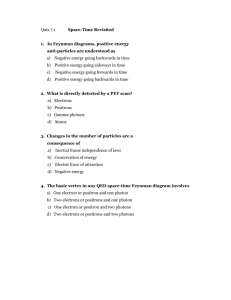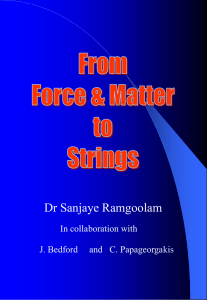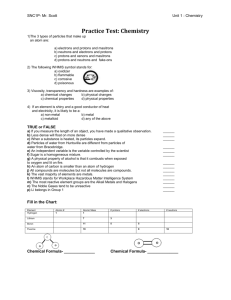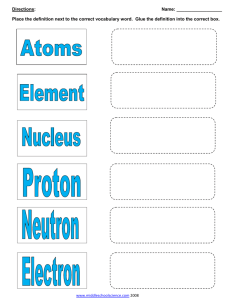Modern Physics
advertisement
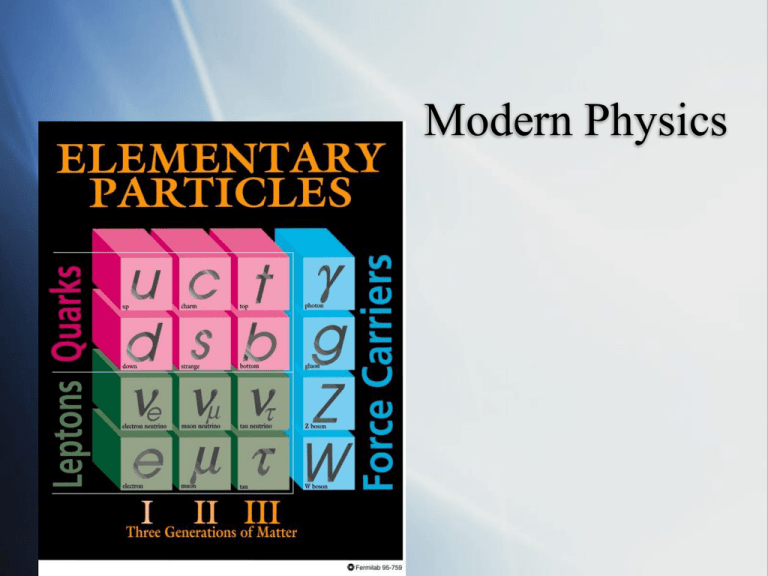
Modern Physics Reinventing Gravity Einstein’s Theory of Special Relativity Theorizes the space time fabric. Describes why matter interacts. The larger the mass the larger the curve in the space time fabric. Objects that are far away have less interaction Duality of Light As seen earlier evidence showed that light can be refracted by gravity. During an eclipse scientists were able to photograph EM radiation from stars behind the sun. The gravity of the sun bent the light. Photoelectric Effect (Quantum Theory of Light) When EM radiation hits an object and the object emits electrons (EX. solar panel) The electron receives energy from the EM radiation. They behaved like particles colliding containing a mass and therefore a momentum. Einstein called these bundles of energy photons. So is light a wave or a particle? Both are correct but also both are incomplete. Lights dual nature is to this day unexplained in full. Wave theory - a beam of electrons move as a wave also. Particle theory - higher intensity should equal higher energy electrons Actually higher frequency light yields higher energy e’s Animation E =hf or E=hc/ E is the energy of the photon h is Planck’s constant (on PRT) f is the frequency of the light Sample Problem #1 Find the energy of a photon of violet light with a frequency of 7.69x1014Hz. E = hf E = (6.63x10-34Js)(7.69x1014Hz) E = 5.1x10-19J Sample Problem #2 The wavelength of a certain color of light is 6.1x10-7m. What is the energy of the photons of light? E=hc/ E= ((6.63x10-34Js)(3.00x10 8m/s))/(6.1x107m) E = 3.26x10-19J Physics and the Atom What happens when light hits an object but does not impart enough energy to cause the object to emit electrons? The Bohr model answers this Electrons with the least amount of energy are in the ground state. If an electron absorbs energy it can transition to a higher energy level called an excited state. For an electron to jump energy levels it must absorb the exact amount of energy needed. The electrons quickly return to ground state and a photon is emitted. Energy of photon is equal to the energy difference between the excited state and the ground state. Ephoton = Ei - Ef We will study 2 elements, Mercury and Hydrogen (PRT’s) *******Energy is given in eV, needs to change to J when using Einstein’s equations******** Sample Problem An electron in an excited hydrogen atom drops from the second level to the first energy level. Calculate the energy, and the frequency of the photon emitted. Ephoton = Ei - Ef E = -3.40 - (-13.6) E = 10.2eV (10.2 eV)(1.6x10-19J/eV) = 1.62x10-18J E=hf f=E/h f = 1.62x10-18J/ 6.63x10-34Js f = 2.4 x1015Hz Sample #2 Is it possible for a Hydrogen atom to absorb 0.47eV? If so what energy level jump is this associated with? n=4 -> n=6 -0.38eV - (-.85eV) = .47eV Subatomic Physics Nucleus Protons Positive charge Mass of 1u or 9.31x102MeV Neutrons Neutral charge Mass of 1u These are called nucleons Binding Energy (mass defect) When comparing the mass of nucleus and the sum of the particles that make it up, the mass of the nucleus is less that the sum of the parts. Einstein theorized this missing mass was turned into energy used to hold the nucleus together. Hence E=mc2 E is energy m is mass c is the speed of light The energy becomes two forces in the atom. Binding Energy Forces Strong Nuclear Force An attractive force that hold nucleons together. Or else protons will repel. Only effective over very short ranges. 10-15 Weak Nuclear Force The interaction between protons and electrons. Appears only during Beta decay as Neutron become protons and emit electrons. These two plus gravity and electromagnetic forces are the 4 known forces of the universe. Elementary Particles Protons, neutrons and electrons were thought to be the smallest particles until 1932. The invention of particle accelerators and particle detectors have since led to the discovery of over 200 new particles. They do not exist separately for very long. Particle detectors measure how gas and other materials interact with these new particles. Force Particles Theoretical physicists have proposed that the forces are an exchange of particles between two objects. Strong Nuclear Force - gluon particles Weak Nuclear Force - W+W- Z gauge bosons Electromagnetic Force - photon Gravity - graviton All have been detected except for the graviton Classifying Matter Open Reference tables to page 3 All matter is either a hadron or a lepton. Leptons do not interact via strong nuclear force, hadrons do. Leptons 6 known - including electrons and neutrinos (no charge, less mass than an electron, result of nuclear reactions on the sun) Hadrons Split into Baryons and Mesons both made up of quarks. Quarks 6 quarks that carry a fractional charge. Each quark is a different flavor, up, down, strange, charm, top, bottom. 3 quarks combine to make a baryon such as a proton (uud). Composed of 2 up quarks and 1 down. By charge: +2/3e + +2/3e + -1/3e = +1e All baryons must be made of quarks whose charge equals a whole number(+ or - ) Anti-particles For each particle, there is a corresponding antiparticle which has an opposite charge but the same mass. Ex. Positron or anti-electron has the same mass as an electron but an opposite charge. These particles only exist for short periods of time. When they interact with their counterpart, they may annihilate releasing photons and gamma rays. Ex. Cosmic radiation Anti-particle or anti-matter has only been found in particle accelerators Mesons Composed of a quark and an anti-quark. Less massive than baryons. Always have a charge that is a whole number. Exist for 10-8 - 10-9 s. Grand Unified Theory (GUT) The physics on a large scale does not match the physics on a quantum scale. Theories such as string theory are trying to tie the two together in order to create a single theory that describes the entire universe. Problem: string theory requires a minimum of 6 dimensions of which we only know 4. Hypothetically up to 11 dimensions.
